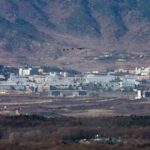
In a major step toward advancing its defense capabilities, South Korea is preparing to deploy its laser-based anti-aircraft weapon, the Cheonggwang, a system capable of neutralizing small unmanned aerial vehicles (UAVs) and drones. The laser system, also known as Block-I, has shown promising results in recent tests and is poised for operational deployment by the end of 2023. This move comes amid growing concerns over North Korea’s increasing use of drones for surveillance and provocations.
The Cheonggwang uses high-energy lasers generated from fiber-optic sources to precisely disable targets. During a demonstration on July 30, 2023, a Phantom 4 drone—typically used by hobbyists—was targeted and destroyed in seconds. The laser struck the drone about 50 cm in size, causing it to catch fire and fall to the ground, marking a successful test of the system’s effectiveness at a range of 1 km.
The Cheonggwang laser system, developed by South Korea’s Agency for Defense Development (ADD), has been designed to provide an efficient, cost-effective response to small UAVs. Unlike traditional missile systems, the laser does not use conventional ammunition, eliminating concerns about collateral damage from falling ordnance. The system’s high precision and relatively low cost—around 2,000 KRW ($1.5) per shot—make it an ideal solution for defending against small, low-cost drones often used in North Korean provocations.
Technology and Performance of the Laser Defense System

The Cheonggwang works by focusing a 20-kilowatt laser beam onto the target, heating it to over 700°C, effectively disabling the drone’s engine and other vital components. This method of destruction is classified as a “hard kill,” where the laser energy is converted into heat, causing physical damage to the target.
Unlike traditional weapons like 20mm or 30mm anti-aircraft guns, which are expensive and resource-intensive, the laser system provides a highly economical solution. For example, intercepting a target with a 20mm Vulcan or a 30mm gun could cost millions of won per shot, while the laser system’s cost per shot is less than 2,000 KRW. This makes the Cheonggwang an efficient and scalable option for South Korea’s defense forces, especially when facing the large-scale use of drones.
Another advantage is the system’s operational flexibility. It can be deployed in urban areas, such as around Seoul’s capital, to defend against threats without risking significant collateral damage. Furthermore, the Cheonggwang has no noise or visible traces, making it difficult for adversaries to track or evade.
Scaling and Future Development of the Laser System
The current version of the Cheonggwang is designed for ground-based fixed deployment. However, the South Korean military is already planning future upgrades, including developing a Block-II version that could be installed on aircraft, ships, or vehicles. By 2030, the South Korean government intends to expand the system’s laser power to 30 kW for greater operational range and effectiveness.
Additionally, the Cheonggwang system is set to be integrated with broader defense networks, including radar and targeting systems, to improve response time and precision in detecting and intercepting incoming threats. Future iterations, such as Block-III, will aim for even higher outputs of up to 100 kW, expanding the system’s potential to engage more complex targets, including cruise missiles and possibly even combat aircraft.
Strategic Implications: Countering North Korean Drone Threats

The deployment of the Cheonggwang laser defense system comes at a critical time, as North Korea has escalated its use of drones for surveillance and low-cost attacks. In December 2022, North Korean UAVs infiltrated South Korean airspace, sparking widespread concern. In response, the Cheonggwang laser system is part of South Korea’s growing countermeasures against these threats, enhancing the country’s defense capabilities without relying solely on high-cost missile systems.
In addition to its technical capabilities, the Cheonggwang provides a rapid-response solution that can be deployed quickly to address sudden incursions, offering South Korea a timely and effective means to neutralize aerial threats before they can cause significant damage.
Operational Deployment and Future Prospects
The South Korean military plans to deploy the Cheonggwang in the capital region starting in December 2023, particularly in response to growing North Korean drone activities and balloon provocations. The system will be stationed in high-traffic areas, such as government buildings and military installations, to protect critical infrastructure.
The success of the Cheonggwang could set a precedent for the global military community, as South Korea is the first nation to field a laser-based anti-aircraft weapon for defense operations. As laser technology advances, it could redefine defense strategies, allowing nations to address new threats efficiently and economically.
In conclusion, the Cheonggwang laser defense system represents a significant leap forward in South Korea’s defense capabilities. With its high efficiency, low cost, and scalability, it is poised to become a vital component of the country’s strategy to counter North Korean drone threats. As laser technology continues to evolve, South Korea’s leadership in this field could have far-reaching implications for modern warfare, making the Cheonggwang a game-changing asset in the region.















Most Commented